Sparkman eGranary Project: History
In much of the work developing and attempting health work force trainings and programs in Zambia in the early 2000’s, two challenges were quickly evident. One was the lack of supportive training materials such as textbooks, manuals, demonstration videos and other materials needed for faculty and students. The second was the challenge of consistent internet access and/or the cost of internet access when it did become available. Thus, although there were many resources developed to be delivered via web based platforms, they were not easily disseminated or were just not available for those most in need.
Beginning in about 2008, the Sparkman Center for Global Health (SCGH) became aware of a system being developed to develop web-based or other e-content called eGranary (eG) (eGranary Digital Library) being developed by the Widernet non-profit located in Iowa at the time. The basic concept of this system is to organize content onto a web-like framework for dissemination in settings without internet connection. For this development permissions are obtained from web sites with pertinent content and are organized and replicated at the time an eGranary unit is distributed.  Basic eGranary Concept
Basic eGranary Concept
In discussions with the Widernet eG development group the SCGH agreed to support the identification of resources supporting health care worker trainings including: nursing, public health, basic sciences and medical officer/physician training programs. These activities were done in collaboration with the UAB PAHO/WHO Collaborating Center for International Nursing (UAB PAHO/WHO Collaborating Center for International Nursing), UAB global health interest groups and staff supported both at Widernet and SCGH. Specific portals were developed and are now called the Zambian or Sparkman Medical Portal. Over 15 million pages of resources were added in this effort.
Within Zambia, SCGH has supported the installation of eG units in the following health care worker training institutions:
- 9 medical school installations (Zambia, Ethiopia)
- 12 nursing school installations (Zambia)
- 18 Teachers training college and resource installations (Zambia)
- Pilot project installation of 12V units in three rural settings (Peace Corps Zambia)
- Procurement order for 600 units for installation in all secondary schools in Zambia in collaboration with Ministry of Education under discussion
- Support local NGO development with focus on IT training and also technical support for eGranary projects in Zambia
In addition, the SCGH has supported eG installations at health care worker training institutions in Malawi, Kenya, and Ethiopia.
At the initial stages of the health workforce focused eG developments a partnership was initiated with a Belgian NGO, VVOB (VVOB) working with the Ministry of Education in Zambia to enhance Zambia-focused primary and secondary school education resources. Resources were collaboratively identified and added to the eG unit in a portal called the Zambia Knowledge Portal. About 5 million pages of content were in this effort. SCGH collaborated with VVOB to train librarians and technicians and install eG units in all 13 of the Teachers Training Colleges in Zambia as well as provincial Teacher Resource Centers. 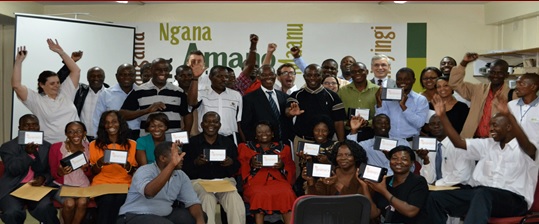 The Sparkman Center for Global Health collaborated with VVOB to train librarians and technicians on the eG unit.
The Sparkman Center for Global Health collaborated with VVOB to train librarians and technicians on the eG unit.
Enhancements and resource development within eG continues in collaboration with Widernet and total resources available on the eG are now over 50 million pages and nearing 6 tb of content. SCGH supported installations continue, but predominantly occur through eG associates developed in Zambia and Ethiopia. One collaborative effort with Widernet and Peace Corps Zambia (Peace Corps Zambia) included the development and dissemination of a 12V self contained eG server disseminated with solar power backing and with access via tablets in 2014; these projects are still being evaluated.
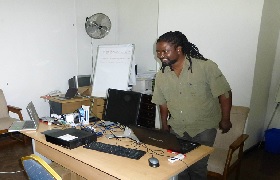 Partnership between the Sparkman Center for Global Health, Widernet and Peace Corps Zambia for the installation of a 12V self contained eG server
Partnership between the Sparkman Center for Global Health, Widernet and Peace Corps Zambia for the installation of a 12V self contained eG server
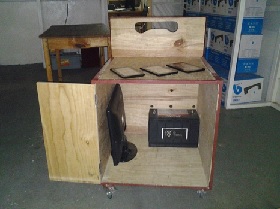 The eGranary 12V server and tablets
The eGranary 12V server and tablets
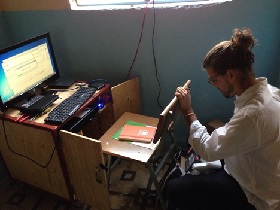 The installation of the eGranary server due to the collaborative efforts of the Sparkman Center for Global Health, Widernet and Peace Corps Zambia
The installation of the eGranary server due to the collaborative efforts of the Sparkman Center for Global Health, Widernet and Peace Corps Zambia
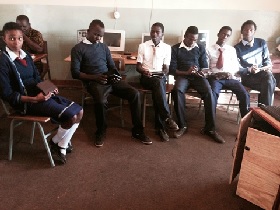 Zambia Secondary School students in orientation for 12V eGranary placement in collaboration with Peace Corps
Zambia Secondary School students in orientation for 12V eGranary placement in collaboration with Peace Corps